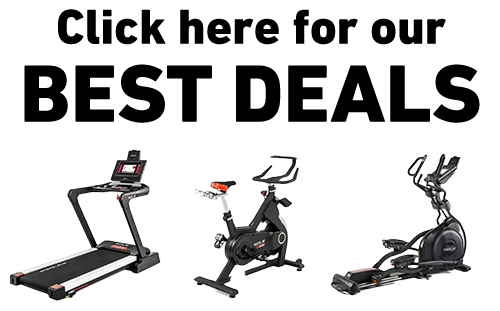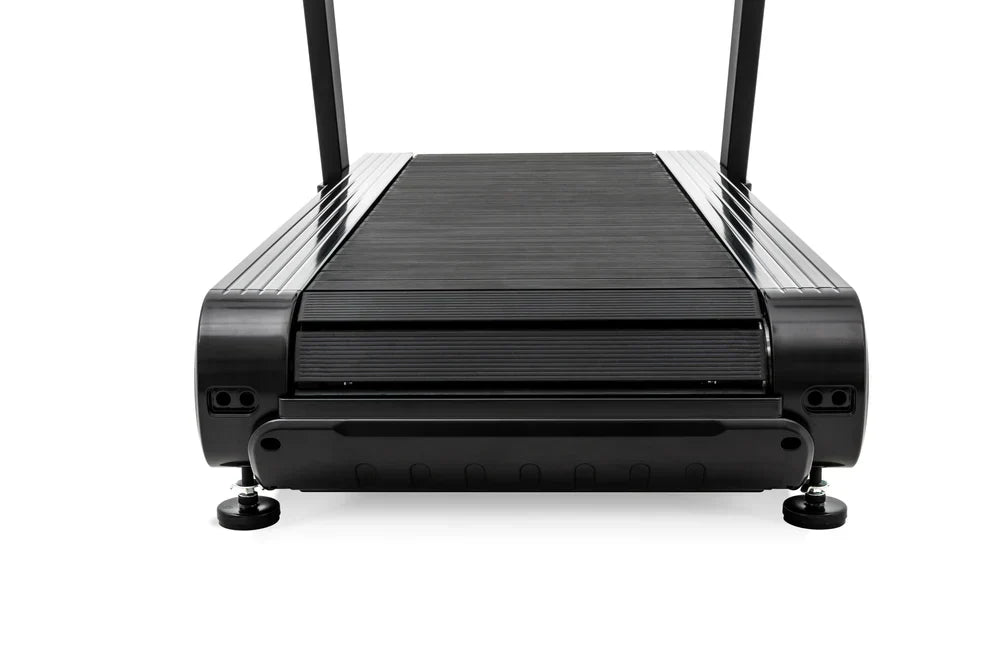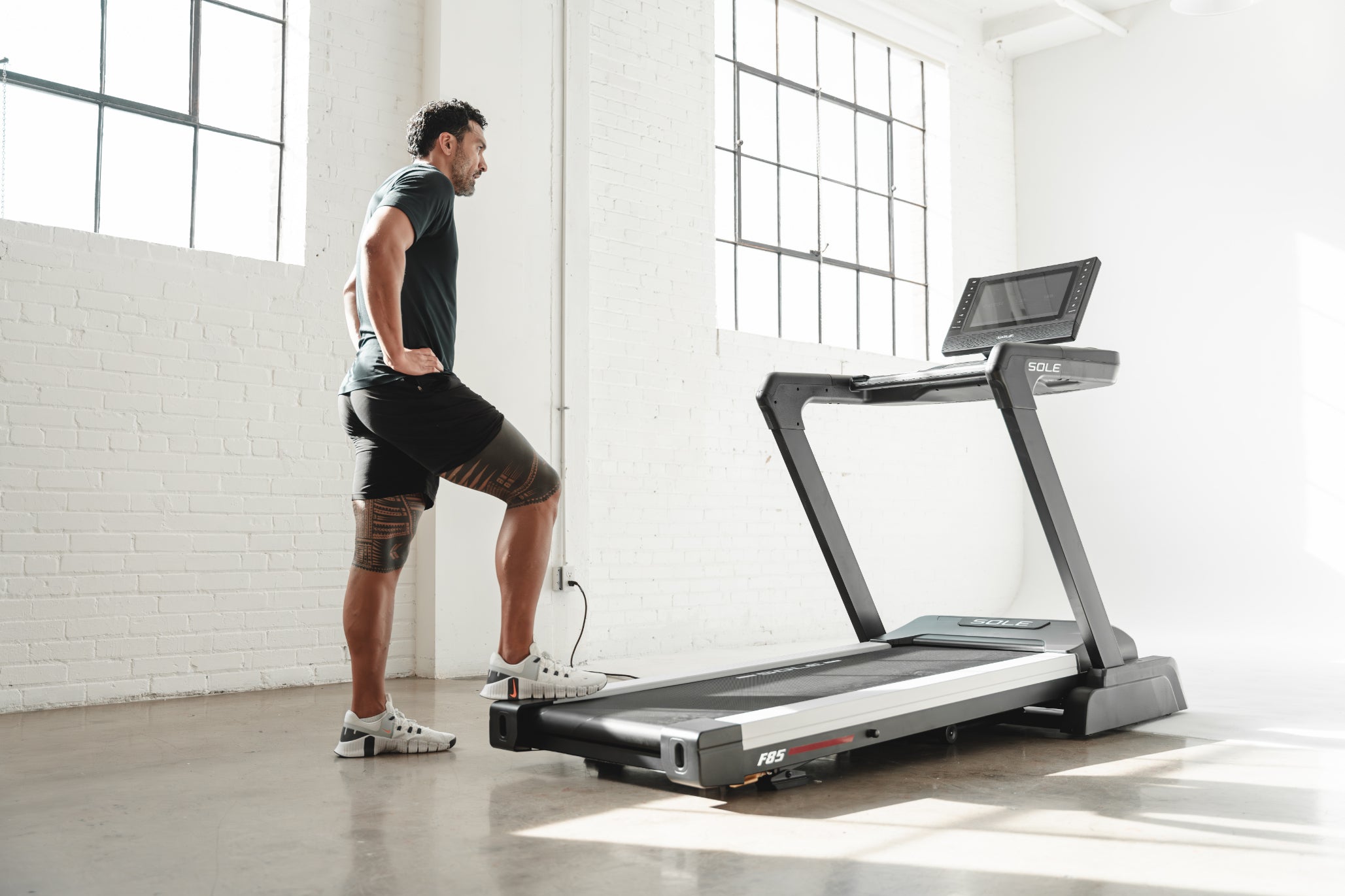Key Takeaways
- A manual treadmill is powered by your own effort, not electricity.
- They are more affordable and compact compared to motorized treadmills.
- Using a manual treadmill can help burn more calories and improve cardio strength.
- Proper usage involves correct foot placement, adjusting speed, and managing resistance.
- Maintaining good posture and varying workouts can maximize your exercise benefits.
|
At SOLE Fitness, we're proud to offer the best motorized treadmills for your home or gym. These machines are crafted to meet the highest standards of quality and performance, ensuring they are ideal for anyone - from fitness novices to seasoned athletes. Featured Product
|
What is a Manual Treadmill?
A manual treadmill is a type of treadmill that doesn't require electricity to operate. Instead, it's powered entirely by your own movement. When you walk or run on a manual treadmill, your feet push the belt, making it move. This means you control the pace and intensity of your workout.
Manual treadmills are often more affordable and compact than their motorized counterparts. They're also quieter and don't need to be placed near a power outlet, making them a convenient option for many home gyms.
Unique Features of a Manual Treadmill
Manual treadmills come with a set of unique features that set them apart from motorized treadmills. Here are some key characteristics:
- User-Powered Operation: You control the speed and intensity by your own effort.
- Adjustable Incline: Many manual treadmills allow you to set the incline, adding an extra challenge to your workout.
- No Electricity Requirement: Since they don't need to be plugged in, manual treadmills are energy-efficient and can be placed anywhere.
- Affordability: Generally, manual treadmills are less expensive than motorized ones, making them accessible to a wider audience.
- Compact Design: These treadmills are often smaller and lighter, making them easier to store and move around.

Here’s how a manual treadmill looks - the one above is by TrueForm.
The Benefits of Using a No Motor Treadmill
Just like motorized treadmills like SOLE F63 and F89, using manual treadmills provides several benefits that can enhance your fitness journey.
Burn Calories
Manual treadmills may help you burn more calories compared to motorized treadmills. Because you have to use your own energy to move the belt, you engage more muscle groups, which leads to higher calorie expenditure. This makes manual treadmills a good choice for those looking to lose weight or maintain a healthy weight. In fact, a 2016 study found that non-motorized curved treadmill users can burn more calories per mile than motorized treadmills.
Strengthen Cardio
The self-powered nature of a manual treadmill requires the user to work harder to maintain their pace and speed. This increased effort translates to a more intense cardiovascular workout, helping to strengthen the heart and lungs. The adjustable incline on many manual treadmills further challenges the cardiovascular system.

All our SOLE motorized treadmills have incline settings that can also help to improve your cardio performance. Our SOLE F85 and TT8 have 6 levels of decline too.
Weight Loss Support
The increased calorie burn from using a manual treadmill can be beneficial for weight loss efforts. By burning more calories per workout, users may be able to create a greater calorie deficit to support fat loss, especially when combined with a healthy diet. The increased muscle activation can also boost metabolism.
Muscle Toning
Using a manual treadmill may engage more muscle groups compared to a motorized treadmill, as the user has to provide the power to move the belt. This includes the leg, core, and arm muscles. The increased muscular effort can lead to improved muscle tone and definition over time.
How to Use a Manual Treadmill
Getting Started
Before you begin, make sure your treadmill is placed on a flat, stable surface. Wear comfortable workout clothes and shoes with good grip. Start by familiarizing yourself with the treadmill's features, such as the incline adjustment and resistance settings.
Stand on the side rails and hold onto the handlebars. Gently place one foot on the belt to get a feel for its movement. Once you're comfortable, step onto the belt with both feet and start walking slowly. This will help you get used to the treadmill's motion.
Proper Foot Placement
Proper foot placement is crucial for a safe and effective workout. Always aim to land on the middle of the belt with each step. Avoid stepping too far forward or backward, as this can cause the belt to stop or move unevenly.
Keep your feet parallel and maintain a natural stride. If you're running, focus on landing softly on the balls of your feet to reduce impact on your joints. Consistent foot placement will help you maintain balance and control.
Adjusting Speed
Unlike motorized treadmills, manual treadmills require you to control the speed with your own effort. Start with a slow walk to get used to the movement. Gradually increase your pace by pushing the belt harder with each step.
If you want to slow down, reduce the force of your steps. Always hold onto the handlebars when adjusting your speed to maintain stability. Find a pace that feels comfortable and sustainable for your fitness level.
Setting the Incline
Just like our SOLE treadmills like the F89, many manual treadmills come with adjustable incline settings. To set the incline, stop the treadmill and carefully adjust the incline lever or knob. A higher incline will make your workout more challenging, simulating an uphill walk or run.
Start with a low incline and gradually increase it as you build strength and endurance. Incline workouts can help target different muscle groups and add variety to your routine.
Managing Resistance
Resistance settings on a manual treadmill allow you to increase or decrease the difficulty of your workout. Higher resistance makes it harder to move the belt, providing a more intense workout.
Adjust the resistance to match your fitness level and goals. Beginners should start with lower resistance and gradually increase it over time. Make small adjustments to avoid overexertion.
Tips for Maximizing Your Workout
Now that you know how to use a manual treadmill, here are some tips to help you get the most out of your workouts. These strategies will enhance your performance, prevent injuries, and keep you motivated.
Maintaining Good Posture
Good posture is essential for an effective workout. Stand tall with your shoulders back and your core engaged. Avoid leaning forward or slouching, as this can strain your back and reduce the efficiency of your movements.

Just like the image above, keep your head up and look straight ahead. This will help you maintain balance and prevent neck strain. Consistently practicing good posture will improve your overall form and workout results.
Using Handlebars Effectively
Handlebars provide support and stability, especially when adjusting speed or incline. However, avoid gripping them too tightly, as this can cause tension in your upper body. Instead, use a light, relaxed grip.

For a more challenging workout, try letting go of the handlebars and swinging your arms naturally. This will engage your core and improve your balance. Just make sure you're comfortable with the treadmill's movement before attempting this.
Varying Your Workouts
Mix up your routine by incorporating different speeds, inclines, and resistance levels. You can also try high-intensity interval workouts (HIIT), alternating between high-intensity bursts and lower-intensity recovery periods.
Experiment with different workout durations and styles, such as walking, jogging, or sprinting. This will keep your workouts exciting and challenging, helping you achieve your fitness goals faster.
Cooling Down Properly
After an intense workout, it's essential to cool down properly. Gradually reduce your speed and resistance, allowing your heart rate to return to normal. Spend a few minutes walking at a slow pace to help your muscles relax and recover.
Finish with some gentle stretching to improve flexibility and prevent stiffness. Focus on the major muscle groups you worked on during your session, such as your legs, back, and shoulders. Cooling down will leave you feeling refreshed and ready for your next workout.
Manual treadmills are an excellent choice for those who want a more natural running experience. Unlike motorized treadmills, they are powered solely by the user's movement, providing a more intense workout. To use a manual treadmill, start by standing on the belt and holding onto the handles. Begin to walk or run, and the belt will move with you. This type of treadmill is great for improving cardiovascular health and building strength.
Comparing Manual and Motorized Treadmills
While manual treadmills offer numerous benefits, it's also worth exploring motorized treadmills for their advanced features and convenience. For instance, our ST90 model with a slat belt provides a smooth, durable running surface and customizable workout programs.
Motorized treadmills can offer more precise speed and incline adjustments, making them suitable for a wide range of fitness levels and goals. Consider trying out different models to find the best fit for your needs and preferences. Check out our SOLE treadmills today.
|
Featured Products
|
Frequently Asked Questions (FAQ)
How does a manual treadmill compare to running outdoors?
Running on a manual treadmill and running outdoors both have their unique advantages.
A manual treadmill allows you to control the pace and intensity of your workout in a controlled environment, making it easier to maintain a consistent routine regardless of weather conditions.
On the other hand, running outdoors offers varied terrain and natural scenery, which can be more engaging and challenging. Both options can be beneficial, so it ultimately depends on your personal preference and fitness goals.
How do I adjust the incline on a manual treadmill?
Adjusting the incline on a manual treadmill typically involves stopping the treadmill and manually setting the incline lever or knob. Most manual treadmills come with a few preset incline levels. To adjust the incline:
- Stop the treadmill and ensure it is stable.
- Locate the incline adjustment mechanism, usually found at the base or near the rear of the treadmill.
- Adjust the lever or knob to the desired incline level.
- Ensure the incline is securely set before resuming your workout.
Always refer to your treadmill's user manual for specific instructions related to your model.
How do I adjust the speed on a manual treadmill?
Unlike motorized treadmills, the speed on a manual treadmill is controlled by your own effort. To adjust the speed:
- Start by walking at a slow pace to get comfortable with the treadmill's movement.
- Gradually increase your pace by pushing the belt harder with each step.
- To slow down, reduce the force of your steps.
- Always hold onto the handlebars when adjusting your speed to maintain stability.
Always find a pace that feels comfortable and sustainable for your fitness level.
How do I adjust the resistance on a manual treadmill?
Adjusting the resistance on a manual treadmill involves changing the tension settings, which makes it harder or easier to move the belt. To adjust the resistance:
- Locate the resistance adjustment mechanism, usually found near the flywheel or belt.
- Turn the knob or lever to increase or decrease the resistance.
- Test the belt's movement to ensure the resistance level is suitable for your workout.
Always make small adjustments to avoid overexertion and gradually increase resistance as you build strength.
Are manual treadmills suitable for all fitness levels?
Yes, manual treadmills can be suitable for all fitness levels. Beginners can start with lower resistance and a flat incline to get used to the treadmill's movement.
As you become more comfortable and build strength, you can gradually increase the resistance and incline to challenge yourself further. Manual treadmills offer a versatile workout option that can be adjusted to match your fitness level and goals.




Leave a comment
This site is protected by hCaptcha and the hCaptcha Privacy Policy and Terms of Service apply.